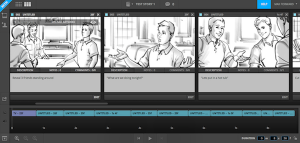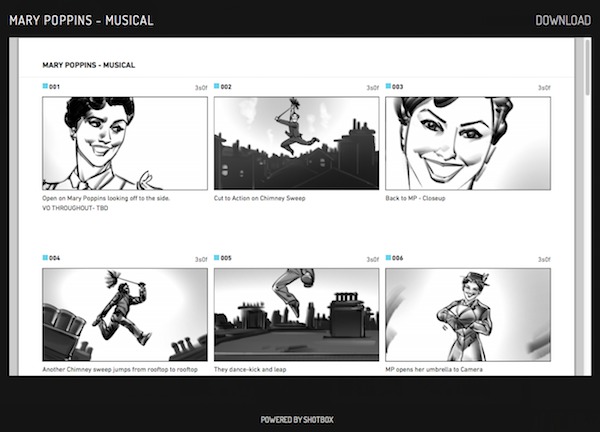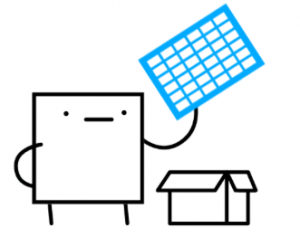UPDATE 3/25/2015 – Sorry to pass along some news: Shotbox.se has shut down, and so this post is basically moot. Shotbox used an online subscription model, and had promising but limited applicabilities as far as producing presentation-style storyboards. For their part, on their website at least, they say they don’t have the time or money to maintain the product.
What went wrong? Well, I’d just be speculating and can’t speak for them. As I discuss in my original post, Shotbox was very promising and I was curious to see how it developed. As it was, I found it useful as it was simple, intuitive, and had some neat features, like generating basic animatic movies and shared workflows. But the only feature it had that I really cared about was the ability to easily swap boards and have them resequence automatically, and it lacked very important features that I would have needed to use it professionally: The ability to customize headers and fonts and other basic design details. The online-only functionality was not convenient, it really seemed unnecessary other than to maintain subscribers and prevent piracy, I suppose, and in the end was a big deterrent for me. I would have easily paid $25 – 50 for a standalone version, even without the requested features I listed above. I would have even recommended it and I think that it could have eventually panned out for them. Now they are gone, and we are left with the other bloated, restrictive, and expensive alternative, Toon Boom Storyboard Pro v.whatever.
Storyboarding is a weird field- there’s not a one-size fits all approach, and each artist and project is very different from the next- If you are interested in making a killer app for storyboarding, and I encourage you to try, PLEASE LISTEN:
- Make it affordable, like under $80 for something full-featured, and not tethered to online sharing services or subscriptions.
- Drawing tools need not be included! You aren’t going to make a better drawing app than Photoshop or whatever else is already out there. Just give it the ability to import image files of various formats and sizes.
- You just need to be able to CUSTOMIZE (many options for numbering, text, fonts, titles, headers, logos, layouts, colors, sizes, etc) storyboard presentations and save those formats for future use.
- The ability to quickly swap, delete, and add frames into a sequence and have it automatically renumbered and laid-out is KEY. LIKE THE MOST IMPORTANT THING.
- For the love of god, make it MAC COMPATIBLE 🙂
Alright, well, that’s my spiel. Geez, 10 years in the biz, and still not a decent, basic, storyboarding app. Somebody, make this happen, and take my money too!! Anyway, below, please find the original post.
Just a couple of weeks ago on this here bloggy thing I was griping about Toon Boom Storyboard Pro’s latest “update” and how it basically isn’t that impressive to me. The drawing tools were still rather primitive and the export options just as unattractive as before. All for the low, low price of $999. No thanks. Let me be absolutely blunt: TBSP is a poor drawing program grafted on a poor sequencing and layout application, from a strange and terrible futuristic “Soylent Green” type universe where strawberry jam costs $150. I can’t wait for these guys to get toppled by some nimble upstart… you can guess where this is going 😉
Enter Shotbox, which I discovered recently via Twitter (Follow me: @max_forward). Shotbox is a very easy to use storyboard sequencing and layout program that I encourage you to try out. In the little time I’ve spent using it, it’s made a very big impression on me as a killer storyboarding app. It’s currently in beta testing.
To be clear, Shotbox does not include any drawing tools, or the ability to manipulate the images (i.e. zoom, crop, add arrows) once inside the app. You have to draw and export your individual frames using a different program, like Photoshop. I don’t mind that at all; in fact, I appreciate that the creators of Shotbox are instead focused on the challenges of storyboard layout, export, collaboration, revision, and distribution.
BTW- I don’t intend for this post to be an official review of Shotbox- I just want to highlight some points of interest and a few things to watch out for. I may get some things wrong or they may be changed or worse by the time this is posted. I encourage you to evaluate it for yourself.
To get the basics stated quickly: Shotbox allows you to create a storyboard sequence and quickly and easily add images, descriptive text, notes, timing information, etc etc, basically everything you would want to see in a storyboard. And of course, it allows to dynamically rearrange and renumber the sequence on the fly, meaning that revisions are painless. So, it definitely does the basics and it does them very well, from what I can tell.

The PDF export options are beautiful, simple. They are, in some ways, rather limited (for example, you cannot currently include a header logo, which is a problem for me), but the options they provide are well-designed and useful. Final exports can be downloaded and edited in Adobe Illustrator (I haven’t tried this yet).
Also included is an optional video timeline, which is easy to use, where you can add an audio track (I haven’t tried this option) and export an animatic (I have tried this, and it works well).
Something Shotbox does that I’ve not seen elsewhere, is the ability to label (via color coding) the shots themselves, for whatever utility that might provide. I can see potential in that, as a method of distinguishing Alternate Shots from the main sequence.
Also new to me in this app is the ability to save multiple draft versions and revisit earlier edits. Personally, I never make mistakes, so I won’t need this function, but I could see it being of use to others… 🙂 In all seriousness, this is pretty cool.
Here’s the real game-changer: Shotbox is, as far as I can tell, a fully online application, meaning you access it via your web browser and the files are uploaded to their cloud servers. This allows for ease-of-edit from multiple collaborators and streamlined method of distribution in multiple formats. Directors and Producers can leave notes for the artist on individual frames, or make the edits themselves, in case the artist is doing some serious drinking and not to be disturbed. I’ve not thoroughly tested these features, though. And of course, not having an off-line version could be viewed as a downside in some scenarios. But overall, these “cloud collaborative” features are a major plus and definitely the future of storyboarding.
Aside from adding the ability to insert logo headers on the pdf exports (an absolute requirement in commercial storyboarding, lacking in the beta version of Shotbox), which I’ve already written to them to suggest, a feature I’d love see included in the final build is a “Pitch Mode” option for export. Let me explain what that might entail: Right now, their export options, while beautifully designed (I like the font choices and overall balance to the page layouts), include with each frame information that is not helpful when pitching a board to a client. And when I say client, I mean my client’s client, and by that I mean my director is pitching it to his client, an ad agency executive, who is not necessarily savvy when it comes to interpreting storyboards. Anything beyond the frame number and frame description is potentially confusing to a client- and so Shotbox’s frame labeling (a small colored square) and frame timing information (a rather cryptic-looking format: 1s23f, 0s12f, 3s0f, etc) are potentially hazardous. The pitch is a very tense period of decision on the part of the executive and they look for any excuse to reject a proposal- and as such, superfluous information must be edited out of the pitch. So I would love to see a “Pitch Mode” option for export, that allows only the basic information that needs to communicate the story: No labeling or timing info.
But as a platform for quickly producing high quality Shoot Boards (client-approved boards that are used by production staff) and Animatics, Shotbox has no equal.
I’ve taken a moment (it really didn’t take long) to throw together a board I put together using Shotbox. I recycled frames from an earlier project not shown yet on this blog- Mary Poppins, the Musical! Check it out!

As of this writing, the beta only allows 3 test project per user, but I expect that to change once they introduce a pricing model. It’s not far from market-ready, from what I can see. They’ve been active on Twitter, so I encourage you to follow them at @shotbox for future updates.


One response to “There’s a new player in town… introducing Shotbox”
Testing…. comments now enabled.